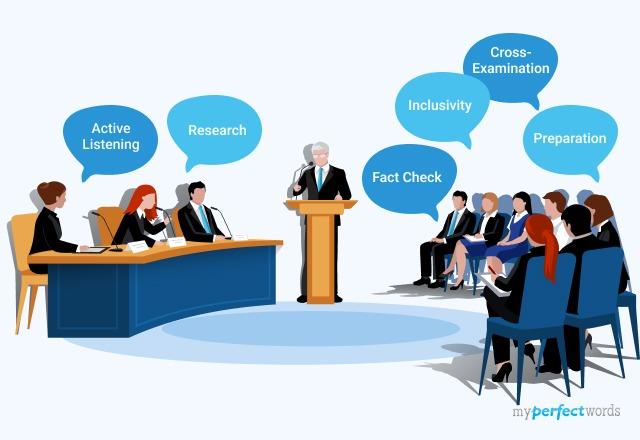
Debating is a useful skill that helps students to think critically, communicate effectively, and advocate for their beliefs. It also helps individuals learn the art of public speaking.
If you're a student preparing for a school debate, a competitive debater, or someone looking to enhance their persuasive abilities, then you are at the right place.
This comprehensive guide is here to help you. We will tell you, in detail, about different techniques and how to utilize them as well.
Not only that, but we will also tell you about the good and bad techniques you should be mindful of.
Let's dive right in!
On This Page![]()
- 1. Techniques for Different Types of In-Classroom Debating
- 2. Advanced Debating Techniques
- 3. Debating Errors to Avoid
Techniques for Different Types of In-Classroom Debating
These techniques involve students in discussions, helping them express their viewpoints and learn how to build strong arguments.
Let’s dive into the details of the types of in-classroom debating techniques.
Techniques for Structured Debates
In a structured debate, students are expected to follow a specific format. This format includes opening statements, cross-examinations, and closing arguments.
Each aspect of the debate is time-bound, ensuring that students present their arguments and respond to their opponents within set time limits.
Here are some techniques you should keep in mind:
- Clear Opening Statements: Craft clear and concise opening statements. Clearly present your stance on the topic and outline the key points you'll address during the debate.
- Strategic Use of Time: Be mindful of the time constraints in each segment of the debate. Allocate your time wisely to ensure you cover all essential aspects of your argument.
- Engage in Active Listening: Pay close attention to your opponents' opening statements. Active listening is crucial for formulating relevant and impactful responses during cross-examinations.
- Effective Cross-Examinations: During cross-examinations, ask probing questions that challenge the foundations of your opponent's arguments. Be prepared to respond thoughtfully to their inquiries as well.
Techniques for Panel Discussions
Panel discussions provide a collaborative platform for students to explore a topic or issue from multiple viewpoints.
Participating in panel discussions allows students to develop essential skills, such as active listening, collaboration, and the ability to express their viewpoints clearly and persuasively.
Here are some tips to have a successful participation in panel discussion:
- Thorough Preparation: Research the panel topic thoroughly in advance. Familiarity with the subject allows for more meaningful contributions to the discussion.
- Know Your Role: Clarify your role in the panel. Whether you're an expert, moderator, or contributor, understanding your role enhances your effectiveness during the discussion.
- Encourage Inclusivity: Foster an inclusive environment by actively inviting contributions from all panelists. Ensure that everyone has an opportunity to express their viewpoints.
- Respectful Disagreement: Embrace diversity of thought and be open to respectful disagreement. Acknowledge opposing viewpoints and provide constructive responses rather than dismissing differing opinions outright.
Techniques for Fishbowl Debates
In a fishbowl debate, a small group of participants engage in a focused conversation while others observe.
The participants in the "fishbowl" actively contribute to the discussion, while those on the outside listen and take notes.
Here are tips to enhance your participation in a fishbowl debate as a participant:
- Encourage Balanced Participation: Be mindful of the dynamics within the fishbowl. Encourage all participants to contribute, ensuring a diversity of perspectives.
- Engage with Others' Ideas: Respond thoughtfully to the ideas presented by fellow fishbowl participants. Acknowledge and build upon their contributions.
- Avoid Dominating the Discussion: While active participation is encouraged, avoid dominating the conversation. Create space for others to express their viewpoints.
- Mind Time Constraints: Ensure that the discussion remains focused and that all key points are addressed within the allocated time.
Here are tips to enhance your participation in a fishbowl debate as an observer:
- Active Listening: Actively listen to the discussion inside the fishbowl. Take notes on key points, arguments, and any notable exchanges.
- Prepare Thoughtful Questions: Formulate thoughtful questions based on the discussions within the fishbowl. These questions can be used during designated Q&A sessions.
- Respectful Observation: Observe respectfully without interrupting the flow of the fishbowl discussion. Your role is to contribute during designated moments.
- Engage in Post-Debate Reflection: Participate actively in post-debate reflections. Share your observations and contribute to the collective learning experience.
Advanced Debating Techniques
Now, let's elevate your debating skills with advanced techniques that can take your persuasive abilities to the next level.
Your choice of words, tone, and delivery can create powerful emotions and make your debates more memorable.
Techique# 1: Create Emotional Resonance With Audience
Debating is more than just facts; it's about connecting emotionally. You can use empathy, humor, or storytelling to make your arguments not just understood but felt.
Here are some phrases you can use to achieve emotional resonance;
Using Powerful Metaphors
- This issue is a ticking time bomb...
- A ripple effect that touches every corner...
- A cloud that looms over our collective future...
- A mountain we must climb together...
Creating Vivid Imagery
- Envision a world where...
- Painting a picture of...
- See the faces of those affected...
- The vivid imagery of...
Evoking Empathy
- Imagine for a moment...
- Put yourself in their shoes...
- Consider the impact on individuals like...
- Think about the personal stories behind the statistics...
Appealing to Shared Values
- As a society, we value...
- Our shared commitment to...
- Reflecting on our common principles...
- Considering the ideals we hold dear...
Using Personal Anecdotes
- Allow me to share a personal experience...
- I once knew someone who...
- In my own life, I've witnessed...
- Picture this real-life scenario...
Techique# 2: Building Credibility: Be a Trustworthy Source
Building credibility helps you become a trustworthy and knowledgeable source. This can help make your arguments more convincing.
Transparency in sources, expertise, and ethical conduct amplifies the impact of your words.
Here are some tips on how you can build credibility in a debate:
- Thorough Research: Conduct in-depth research on your debate topic. A well-informed debater is inherently more credible.
- Cite Reliable Sources: Support your arguments with credible and reputable sources. This demonstrates that your information is grounded in reliable data.
- Be Transparent About Sources: Clearly state your information sources during the debate. Transparency about where you gather your facts adds a layer of honesty to your presentation.
- Acknowledge Opposing Views: Acknowledge and address counterarguments. Demonstrating a fair understanding of opposing viewpoints shows intellectual honesty and strengthens your credibility.
Techique# 3: Engaging Your Audience
Narratives are your secret weapon to engage and resonate with your audience.
You can craft compelling stories using case studies, personal anecdotes, or historical parallels. Narratives can make your points not only memorable but also relatable to your peers.
Here are some tips you should keep in mind that will help you keep your audience engaged:
- Choose Relevant Stories: Select narratives that directly relate to your debate topic. Ensure they align with the theme and contribute to the overall understanding of your argument.
- Case Studies: Incorporate relevant case studies to provide concrete examples supporting your argument. Real-world instances make your points more tangible and persuasive.
- Maintain a Clear Purpose: Ensure that each narrative serves a specific purpose within your argument. Avoid unrelated arguments that may distract from your main points.
- Encourage Visualization: Prompt your audience to visualize the scenarios you describe. Encouraging mental imagery enhances engagement and leaves a lasting impression.
Techique# 4: Analyzing Opponents' Arguments
Success in debates requires precision in dissecting opponents' arguments. A better understanding of your opponents' positions is the foundation for crafting strong counterarguments.
Here are some tips you should keep in mind when analyzing an opponent’s arguments:
- Active Listening: Pay close attention to your opponents' statements during the debate. Actively listening allows you to grasp the nuances of their arguments.
- Understand Their Main Points: Identify the core messages of your opponent's arguments. Understanding their main points is crucial for formulating targeted counterarguments.
- Identify Assumptions: Uncover any underlying assumptions in your opponents' arguments. Questioning these assumptions can reveal weaknesses in their logic.
- Anticipate Potential Responses: Anticipate how your opponents might respond to your counterarguments. This foresight allows you to prepare additional rebuttals and strengthen your position.
Techique# 5: Constructing Powerful Counterarguments
Crafting counterarguments is more than just disagreeing. Build counterarguments that not only refute opposing claims but also strengthen your own position.
It is important to use logical reasoning and credible evidence to make your counterarguments resilient in the face of opposition.
Here are some tips for constructing strong counterarguments:
- Understand Opponents' Claims: Understanding their perspective enables you to address specific points effectively.
- Identify Weaknesses: Pinpoint weaknesses in your opponent's arguments. This could include logical fallacies, gaps in evidence, or flawed assumptions.
- Use Logical Reasoning: Apply logical reasoning to structure your counterarguments. Clearly articulate the logical connections between your claims, evidence, and conclusions.
- Address Potential Biases: Acknowledge and address potential biases in your counterarguments. A transparent acknowledgment of potential biases enhances your credibility.
Debating Errors to Avoid
Recognizing the difference between good and bad techniques is essential in building credibility.
Here are some bad debating techniques you should avoid;
- Undermine the clarity and coherence of your arguments.
- Rely on flawed logic, weak evidence, or unreliable sources.
- Fail to engage your audience or make your arguments less persuasive.
- Resort to personal attacks, logical fallacies, or disrespectful behavior.
So there you have it!
In this comprehensive blog, we have gone into detail about different debating techniques and how to put them into practice. We have also provided you with the techniques you should avoid.
However, if you are not sure about your writing abilities, this is where the professional help from MyPerfectWords.com comes in.
We provide the best speech writing service where you can get the required help from our best essay writers. Moreover, with our knowledge and expertise, we guarantee you the delivery of the debates within the given deadline.
Say 'do my essay for me', and we will ensure your essay is written with care and delivered on time.
Don't waste your time thinking, because the clock is ticking and you need to get your work done on time!
Frequently Asked Questions
Why is debating a good skill?
Debating is a great way to develop critical thinking skills that will be helpful in everyday life. Critical thinking entails the ability to make well-thought-out arguments with reasoning. Also, it questions evidence behind one's conclusion or stance on an issue at hand.

Write Essay Within 60 Seconds!
Use our AI tool to generate high quality essay
WRITTEN BY
Cathy A.
Cathy has been been working as an author on our platform for over five years now. She has a Masters degree in mass communication and is well-versed in the art of writing. Cathy is a professional who takes her work seriously and is widely appreciated by clients for her excellent writing skills.
Struggling With Your Paper?
Get a custom paper written at
50%DISCOUNT
With a FREE Turnitin report, and a 100% money-back guarantee
Order Now at 50% OFFLIMITED TIME ONLY!

Keep reading
Debate Writing - A Comprehensive Writing Guide
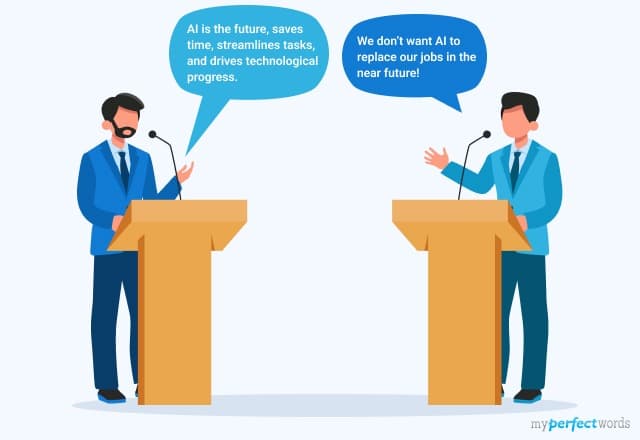
A List of 190+ Debate Topics and Ideas

Debate Speech - Ultimate Writing Guide for Students
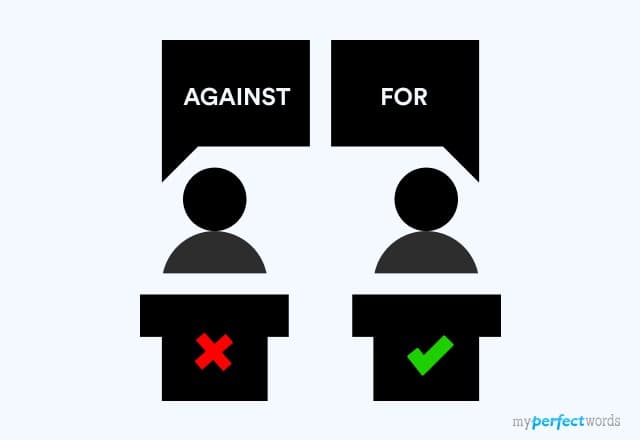
Types of Debate - A Complete Overview & Examples

Free Debate Examples for All Academic Levels
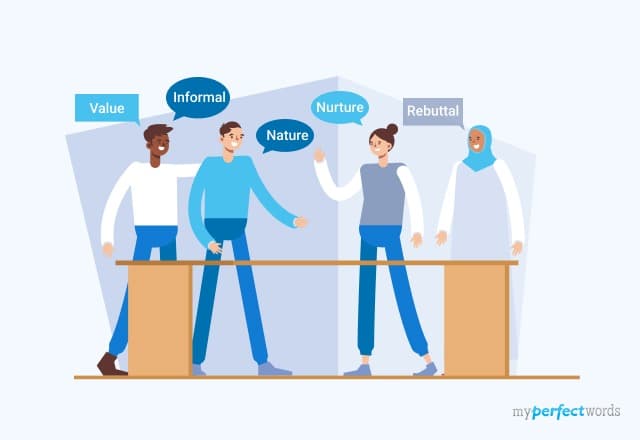
10 Debate Tips and Tricks for Students
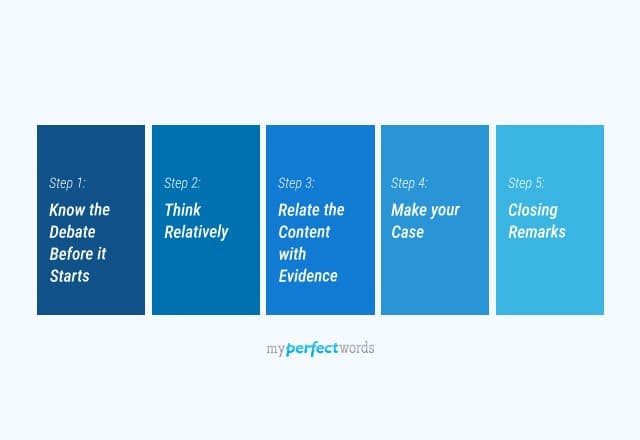

OFFER EXPIRES SOON!
Order Now